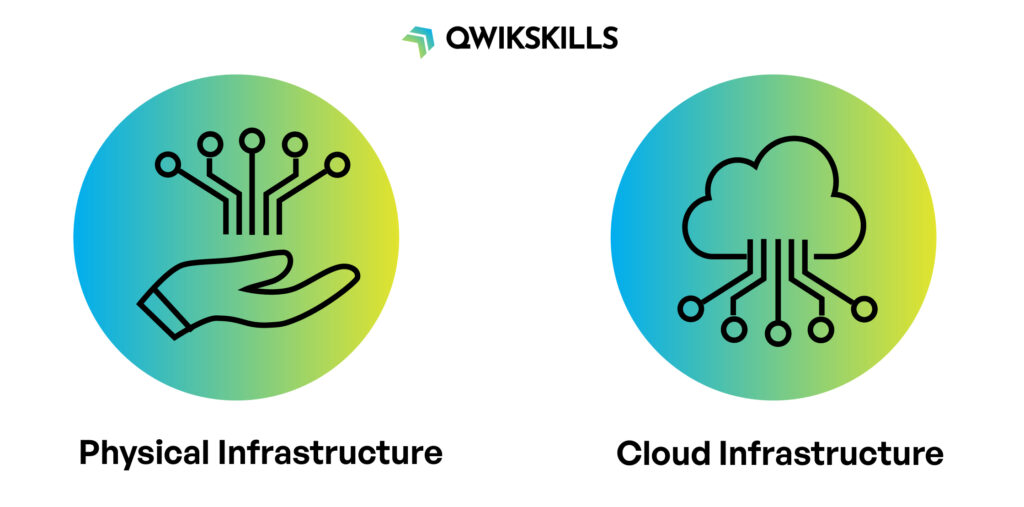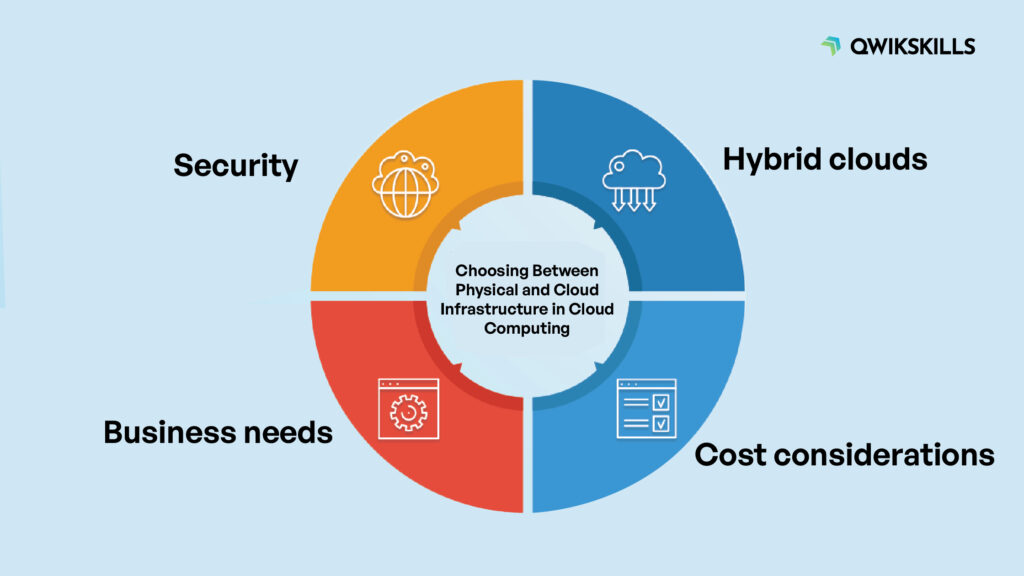In today’s digital era, Cloud Computing has become an indispensable technology for businesses of all sizes. It provides the flexibility, scalability, and cost-effectiveness that traditional physical infrastructure often struggles to match. In this beginner’s guide, we will explore the differences between physical infrastructure and cloud infrastructure, helping you understand the benefits and considerations of each option.
Physical Infrastructure
Physical infrastructure refers to the traditional on-premises setup, where businesses own and manage their hardware and software resources. This includes servers, storage devices, network equipment, and data centers. While an actual foundation offers unlimited authority over assets, it accompanies specific difficulties. It necessitates a significant initial investment in capital, upkeep, and space. However, due to specific requirements regarding security and compliance, some businesses still prefer physical infrastructure.
 Cloud Infrastructure
Cloud Infrastructure
Cloud infrastructure connects computers and services to the Internet. It includes cloud service providers’ data centers, virtual servers, storage, and networking. Cloud framework offers various benefits, including adaptability, and cost reserve funds. Without the need for significant upfront investments, businesses can without a doubt increase or decrease assets using cloud administrations. Additionally, businesses can quickly adapt to shifting market conditions thanks to cloud infrastructure’s increased agility.
Physical vs Cloud Infrastructure Comparison In Cloud Computing
There are a number of factors to consider in cloud computing:
Cost: Physical infrastructure requires significant upfront capital expenditure for hardware, software licenses, and maintenance. On the other hand, cloud infrastructure operates on a pay-as-you-go model, allowing businesses to pay only for the resources they use. This flexibility often translates into cost savings for businesses, especially for those with variable workloads.
Scalability: Physical infrastructure has limitations in terms of scalability. Expanding or reducing resources can be time-consuming and costly. In contrast, cloud infrastructure provides near-instant scalability, allowing businesses to quickly adjust their resource allocation to meet changing demands. This scalability ensures optimal performance during peak periods and cost optimization during slower periods.
Flexibility: Cloud infrastructure offers unparalleled flexibility. It enables businesses to access resources from anywhere, at any time, using various devices. With cloud services, employees can collaborate remotely, fostering productivity and enabling seamless workflows. Physical infrastructure, on the other hand, is confined to a specific location, limiting flexibility and remote accessibility.
Reliability: Both physical and cloud infrastructures can provide reliable services, but cloud infrastructure often offers higher levels of reliability and redundancy. Cloud service providers have multiple data centers across different regions, ensuring data backup and disaster recovery measures. This redundancy minimizes the risk of data loss and enhances business continuity.
Choosing Between Physical and Cloud Infrastructure in Cloud Computing
Businesses must consider the following when choosing between physical and cloud infrastructure:
Business needs: Evaluate your specific requirements, such as security, compliance, and data management. Some industries with strict regulatory standards may opt for physical infrastructure to maintain greater control over their data.
Cost considerations: Analyze your budget and long-term cost projections. Cloud infrastructure’s pay-as-you-go model can be more cost-effective for businesses with variable workloads or limited initial capital investment.
Security: Both physical and cloud infrastructures can be secure when properly implemented. However, cloud service providers often have robust security measures in place, including encryption, access controls, and regular audits. Ensure the cloud provider meets your security requirements.
Hybrid cloud: Many businesses adopt a hybrid cloud approach, leveraging both physical and cloud infrastructure. This allows for a balance between control, security, and flexibility. Critical or sensitive data can be stored on-premises, while non-sensitive workloads can be hosted in the cloud.

Understanding the differences between physical infrastructure and cloud infrastructure is essential for businesses and IT professionals alike. While physical infrastructure offers control and may be suitable for specific security needs, cloud infrastructure shines in terms of scalability, flexibility, cost-effectiveness, and reliability.
With cloud infrastructure, businesses can harness the power of the cloud, accessing resources on-demand and paying only for what they use. This eliminates the need for substantial upfront investments and allows for rapid scaling to meet fluctuating demands. The ability to access resources remotely and collaborate seamlessly enhances productivity and fosters agility in today’s dynamic business environment.
Cloud infrastructure also offers greater reliability through redundancy and robust data backup and recovery measures. With multiple data centers located in different regions, the risk of data loss is minimized, ensuring business continuity even in the face of unforeseen events.
However, the choice between physical and cloud infrastructure ultimately depends on your specific business needs. If your industry requires stringent security and compliance measures, physical infrastructure may be the preferred option. It offers complete control over data and infrastructure, allowing for customized security solutions.
On the other hand, for businesses with limited budgets, variable workloads, or a need for rapid scalability, cloud infrastructure proves to be a game-changer. The pay-as-you-go model and near-instant scalability make it an attractive choice for startups, small and medium-sized enterprises, and businesses experiencing growth or seasonal fluctuations.
It’s worth noting that a hybrid cloud approach can also be a viable solution. By combining physical infrastructure with cloud services, businesses can strike a balance between control, security, and flexibility. Critical or sensitive data can be stored on-premises, while non-sensitive workloads can be seamlessly hosted in the cloud.
Conclusion
Understanding the differences between physical infrastructure and cloud infrastructure is crucial for making informed decisions that align with your business goals and requirements. While physical infrastructure offers control and may be suitable for specific needs, cloud infrastructure empowers businesses with scalability, flexibility, cost savings, and enhanced reliability. By carefully assessing your needs, considering cost implications, and prioritizing security, you can choose the right infrastructure model to propel your business into the future of technology. Embrace the cloud and unlock the full potential of your business!
Ready to embrace the power of cloud infrastructure? Qwikskills is here to help! Our expert team can guide you through the process of transitioning to the cloud, optimizing costs, and maximizing productivity. Contact us today and embark on your journey towards a scalable, flexible, and cost-effective future with Qwikskills!



